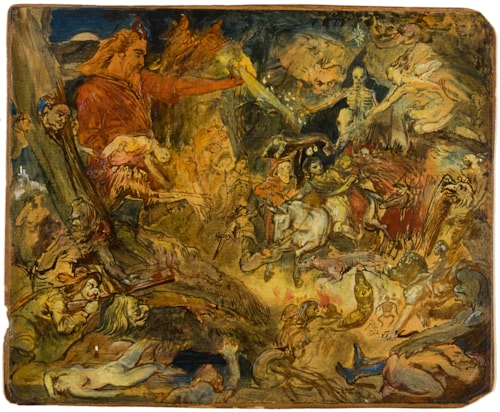
Theodore VON HOLST
London 1810 - London 1844
Biography
Theodor Richard Edward von Holst, succintly described by one recent scholar as ‘the youngest, latest, and most gifted of the pupils of Henry Fuseli’, was the son of a musician from Riga who had settled in England in 1807. He began studying with the aged Johann Heinrich (Henry) Fuseli, Keeper and Professor of Painting at the Royal Academy, in 1820, and entered the Royal Academy Schools four years later, in 1824. Although Fuseli died when Von Holst was fourteen, his influence remained strong on the young artist throughout his brief career. He also came to the attention of the eminent portrait painter Sir Thomas Lawrence, who bought a drawing from the ten-year-old Von Holst for three guineas, and later commissioned a series of erotic drawings from him on behalf of King George IV. An immensely talented and precocious artist, as a young boy Von Holst had already fixed upon the fantastical subject matter for which he would be best known. As one anonymous contemporary author recalled of a visit to the artist, then only sixteen years old, in his studio: ‘the works that surrounded him...were far more interesting to me than even that of the youth himself. They were many in number, and great in talent; wild they were certainly, but they possessed the wildness of a poetic imagination, and displayed great power of execution...I could never get a clue to his meaning, but he delighted in the vague and the terrible.’
Von Holst first exhibited at the Royal Academy in 1827, and continued to show there regularly until his early death from liver failure, at the age of thirty-three. His work was characterized by a preference for macabre and supernatural themes, occasionally with erotic undertones, and often derived from Romantic literary sources, including the stories of E. T. A. Hoffmann, Friedrich de la Motte Foucqué, Victor Hugo and Mary Shelley. (The frontispiece to an illustrated edition of Shelley’s Frankenstein, published in 1831 - ‘surely one of the quintessential gothic images…[showing] the monster coming to life amid a litter of books and bones while his creator flees the room’, as noted by one scholar - is one of the artist’ best-known works.) Johann Wolfgang Goethe’s Faust, published in 1808 and 1832, was a source of particular inspiration for Von Holst, who produced several drawings and paintings inspired by scenes from the book. Indeed, as early as 1827 he had planned a series of twelve drawings of scenes from Faust, to be reproduced as prints by the engraver John Sartain. This project was never completed, however, perhaps because it had been superseded by Delacroix’s own series of Faust lithographs, which appeared in 1828. Furthermore, as Martin Butlin has noted, ‘The protean character of Von Holst’s art is reflected in the way in which his fairy imagery links him with the early works of Richard Dadd and the whole school of Victorian fairy painters.’ Von Holst was also an influence on some of the Pre-Raphaelite artists, notably Dante Gabriel Rossetti, who shared a love of romantic literature with the older artist, and owned a sketchbook by him. Towards the end of his career, a large painting of The Raising of the Daughter of Jarius gained Von Holst a measure of popular acclaim. A few months after his death in 1844, at the age of thirty-three, the contents of his studio were dispersed at auction.
The drawings of Henry Fuseli and Theodor Von Holst have long been confused, and it is largely due to the scholarship of Gert Schiff and, more recently Max Browne, that a clearer understanding of the younger artist’s draughtsmanship has been achieved. Nevertheless, unlike his friend William Blake or his teacher Fuseli, Von Holst remains today a relatively little-known figure in the history of 19th century British art; a situation made more significant by the brevity of his career and the fact that most of his documented works are now lost.


